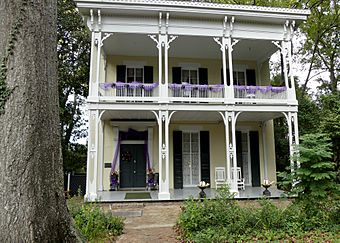McRaven House facts for kids
Quick facts for kids |
|
|
Bobb House
|
|

McRaven House with Halloween decorations
|
|
| Location | 1503 Harrison St., Vicksburg, Mississippi |
|---|---|
| Built | 1797 |
| Architectural style | Greek Revival, Empire, Frontier |
| NRHP reference No. | 79001337 |
| Added to NRHP | January 8, 1979 |
The McRaven House is a very old building in Vicksburg, Mississippi. It was first built around 1797. This historic house is famous for its unique history and different building styles. Many people also believe it is haunted! Some even call it "the most haunted house in Mississippi."
The house was once known as the Bobb House during the American Civil War. It is officially listed on the National Register of Historic Places. McRaven got its current name from the street it sits on, which used to be called McRaven Street.
A Journey Through Time: McRaven's History
The Pioneer Beginnings (1797)
The very first part of McRaven was built around 1797 by a man named Andrew Glass. This section was a simple way station for pioneers. These early travelers were heading to Nashville, Tennessee along the Natchez Trace to the Mississippi River. It had just a kitchen with one room above it. Today, this oldest part of the house is called the "Pioneer Section."
Sheriff Howard's Additions (1836)
In 1836, Sheriff Stephen Howard bought the house. He added a middle dining room and a bedroom above it. These new parts were built in the fancy Empire architectural style. Sadly, Sheriff Howard's wife, Mary Elizabeth, passed away in the house in 1836.
The Bobb Family Era (1849-1869)
John H. Bobb bought McRaven in 1849. He added even more to the house, building the rest in the beautiful Greek Revival style. During the American Civil War in 1863, Vicksburg faced a long siege. McRaven was used as a hospital and camp for Confederate soldiers. Because it was so close to the railroad, a key battle spot, the house was hit by cannon fire. Even so, it managed to survive the war.
In 1864, John Bobb had a conflict with some soldiers near his home. He was shot and passed away. His wife, Selina Bobb, sold the house in 1869. She then moved to a family farm outside New Orleans, Louisiana.
The Murray Family and Time Capsule (1882-1960)
William Murray bought McRaven in 1882. He and his wife, Ellen Flynn, raised seven children there. Several family members, including William and Ellen, passed away in the house over the years. Later, two of their unmarried daughters, Annie and Ella Murray, lived alone in the house. They lived without many modern comforts, except for a telephone.
By 1960, the house was in rough shape. The sisters had even used antique furniture for firewood to stay warm. When Ella passed away, Annie sold the house and moved to a nursing home. Many neighbors didn't even know the house existed because it was so overgrown!
Restoring McRaven's Glory (1960s-1980s)
In 1960, O.E. Bradway bought McRaven. He did some repairs and opened it for tours in 1961. The house was officially added to the National Register of Historic Places in 1979. Later that year, Charles and Sandra Harvey bought McRaven. They spent a year and a lot of money carefully restoring the house. They fixed woodwork, wiring, plumbing, and plaster. They even had special carpet made to match the original design from the John Bobb era. The Harveys worked hard to make sure the house looked just as it did in the past.
In 1984, Leyland French bought McRaven. He continued to restore the house and was the first owner since the Murrays to actually live there. McRaven has stayed mostly the same since the 1800s, except for a modern kitchen and bathroom in the basement. Because it's like a "time capsule," McRaven was featured in National Geographic Magazine in 1963.
Famous Visitors to McRaven
Since opening for tours in 1961, many people have visited McRaven. Among them were actors Max Baer, Jr. and Irene Ryan. They were stars from the TV show The Beverly Hillbillies. They toured the house in the mid-1960s. You can even see an autographed photo of them in the house's foyer!
McRaven on Television
Investigating the Paranormal
The McRaven House was featured on a TV show called Ghost Adventures. The episode, titled "Ghosts of Vicksburg: McRaven Mansion," aired in 2018 on the Travel Channel. A team of investigators explored the house and its grounds. They looked into stories of ghosts, including reports of Andrew Glass, the first builder.



